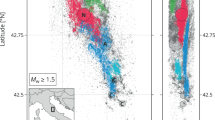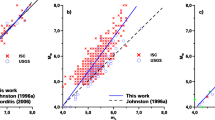Abstract
Large earthquakes are known to trigger earthquakes elsewhere. Damaging large aftershocks occur close to the mainshock and microearthquakes are triggered by passing seismic waves at significant distances from the mainshock1,2,3,4,5,6. It is unclear, however, whether bigger, more damaging earthquakes are routinely triggered at distances far from the mainshock, heightening the global seismic hazard after every large earthquake. Here we assemble a catalogue of all possible earthquakes greater than M 5 that might have been triggered by every M 7 or larger mainshock during the past 30 years. We compare the timing of earthquakes greater than M 5 with the temporal and spatial passage of surface waves generated by large earthquakes using a complete worldwide catalogue. Whereas small earthquakes are triggered immediately during the passage of surface waves at all spatial ranges, we find no significant temporal association between surface-wave arrivals and larger earthquakes. We observe a significant increase in the rate of seismic activity at distances confined to within two to three rupture lengths of the mainshock. Thus, we conclude that the regional hazard of larger earthquakes is increased after a mainshock, but the global hazard is not.
This is a preview of subscription content, access via your institution
Access options
Subscribe to this journal
Receive 12 print issues and online access
$259.00 per year
only $21.58 per issue
Buy this article
- Purchase on Springer Link
- Instant access to full article PDF
Prices may be subject to local taxes which are calculated during checkout




Similar content being viewed by others
References
Hill, D. P. et al. Seismicity in the western United States remotely triggered by the M 7.4 Landers, California, earthquake of June 28, 1992. Science 260, 1617–1623 (1993).
Brodsky, E. E., Karakostas, V. & Kanamori, H. A new observation of dynamically triggered regional seismicity: Earthquakes in Greece following the August, 1999 Izmit, Turkey earthquake. Geophys. Res. Lett. 27, 2741–2744 (2000).
Kilb, D., Gomberg, J. & Bodin, P. Triggering of earthquake aftershocks by dynamic stresses. Nature 408, 570–574 (2000).
Gomberg, J., Reasenberg, P., Bodin, P. & Harris, R. Earthquake triggering by transient seismic waves following the landers and hector mine, California earthquakes. Nature 411, 462–466 (2001).
Gomberg, J., Bodin, P., Larson, K. & Dragert, H. Earthquake nucleation by transient deformations caused by the M=7.9 Denali, Alaska, earthquake. Nature 427, 621–624 (2004).
West, M., Sanchez, J. J. & McNutt, S. R. Periodically triggered seismicity at Mount Wrangell, Alaska, after the Sumatra earthquake. Science 308, 1144–1146 (2005).
Miyazawa, M. & Mori, J. Detection of triggered deep low-frequency events from the 2003 Tokachi-oki earthquake. Geophys. Res. Lett. 32, L10307 (2005).
Rubinstein, J. L. et al. Non-volcanic tremor driven by large transient shear stresses. Nature 448, 579–582 (2007).
Miyazawa, M. & Brodsky, E. E. Deep low-frequency tremor that correlates with passing surface waves. J. Geophys. Res. 113, B01307 (2008).
Peng, Z. & Chao, K. Non-volcanic tremor beneath the Central Range in Taiwan triggered by the 2001 Mw 7.8 Kunlun earthquake. Geophys. J. Int. 175, 825–829 (2008).
Gomberg, J., Rubinstein, J. L., Peng, Z., Creager, K. C. & Vidale, J. E. Widespread triggering of non-volcanic tremor in California. Science 319, 173 (2008).
Velasco, A. A., Hernandez, S., Parsons, T. & Pankow, K. The ubiquitous nature of dynamic triggering. Nature Geosci. 1, 375–379 (2008).
Iwata, T. Low detection capability of global earthquakes after the occurrence of large earthquakes: Investigation of the Harvard CMT catalogue. Geophys. J. Int. 174, 849–856 (2008).
Harris, R. A. Introduction to special section: Stress triggers, stress shadows, and implications for seismic hazard. J. Geophys. Res. 103, 24347–24358 (1998).
Stein, R. S. The role of stress transfer in earthquake occurrence. Nature 402, 605–609 (1999).
Freed, A. M. Earthquake triggering by static, dynamic, and postseismic stress transfer. Annu. Rev. Earth Planet. Sci. 33, 335–367 (2005).
Parsons, T. Global Omori law decay of triggered earthquakes: Large aftershocks outside the classical aftershock zone. J. Geophys. Res. 107, 2199 (2002).
Ellsworth, W. L. & Beroza, G. C. Seismic evidence for an earthquake nucleation phase. Science 268, 851–855 (1995).
Hill, D. P. Dynamic stresses, Coulomb failure, and remote triggering. Bull. Seismol. Soc. Am. 98, 66–92 (2008).
Ziv, A. What controls the spatial distribution of remote aftershocks? Bull. Seismol. Soc. Am. 96, 2231–2241 (2006).
Acknowledgements
We thank E. Brodsky, R. Stein, S. Toda and N. van der Elst for critical comments on written and oral versions of this presentation.
Author information
Authors and Affiliations
Contributions
T.P. and A.A.V. wrote the manuscript collaboratively. T.P. wrote the catalogue search and distance range codes. A.A.V. developed the concept of GSN waveform filtering for remote triggered earthquakes enabling a comparison of large and small events.
Corresponding author
Ethics declarations
Competing interests
The authors declare no competing financial interests.
Supplementary information
Supplementary Information
Supplementary Information (PDF 513 kb)
Rights and permissions
About this article
Cite this article
Parsons, T., Velasco, A. Absence of remotely triggered large earthquakes beyond the mainshock region. Nature Geosci 4, 312–316 (2011). https://doi.org/10.1038/ngeo1110
Received:
Accepted:
Published:
Issue Date:
DOI: https://doi.org/10.1038/ngeo1110
This article is cited by
-
Possible triggering relationship of six Mw > 6 earthquakes in 2018–2019 at Philippine archipelago
Acta Oceanologica Sinica (2021)
-
Earthquake triggering model based on normal-stress-dependent Nagata law: application to the 2016 Mie offshore earthquake
Earth, Planets and Space (2020)
-
Evidence of Systematic Triggering at Teleseismic Distances Following Large Earthquakes
Scientific Reports (2018)
-
Statistical evidence for long-range space-time relationships between large earthquakes
Journal of Seismology (2018)
-
Earthquakes in Oita triggered by the 2016 M7.3 Kumamoto earthquake
Earth, Planets and Space (2016)



